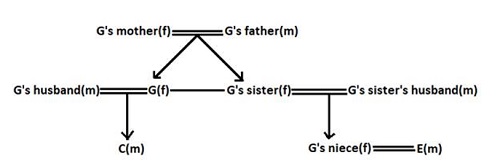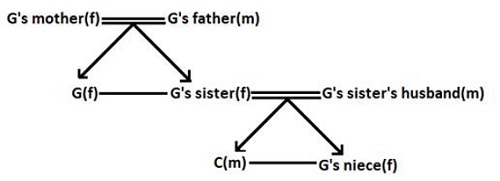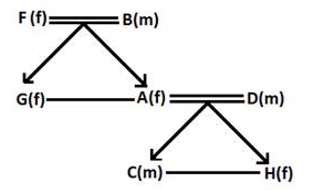Question
How was A related to
E? A family had 8 members A, B, C, D, E, F, G and H. They belonged to 3 different generations and each child had either both or none of his parents alive. • Pointing towards C, G said "he is the only son of my mother's only son-in-law". • Pointing towards B, a person said, "He is the father of my son's mother". • Pointing towards G, a person said, "She is the only sister-in-law of E's father-in-law". • F said, "I have 2 children and 2 grandchildren". • Pointing towards a person, C said, "she is the only daughter of G's sister". • Pointing towards D, F said, "He is the son-in-law of H's grandfather". • A said, "My spouse has no daughter-in-law".Solution
• Pointing towards C, G said, "he is the only son of my mother's only son-in-law". G's mother's son-in-law can be G's husband or G's sister's husband. Thus, C is either the son or nephew of G. • Pointing towards G a person said, "She is the only sister-in-law of E's father-in-law". • Pointing towards a person C said, "she is the only daughter of G's sister". G has a sister and a niece. Case 1: when C is the son of G  In this case we get 9 members, hence the case is invalid. Also, G's mother cannot have 2 sons-in-law. Case 2: When C is G's nephew
In this case we get 9 members, hence the case is invalid. Also, G's mother cannot have 2 sons-in-law. Case 2: When C is G's nephew  E will be either wife of C or husband of G's niece • Pointing towards B a person said, "He is the father of my son's mother". B must be a male. Thus, the person speaking the statement will be G's sister's husband and B will be G's father. • F said, "I have 2 children and 2 grandchildren". F will be G's mother. • Pointing towards D, F said, "He is the son-in-law of H's grandfather". D will be G's sister's husband. H will be G's niece. As E is in the 3rd generation, A will be G's sister.
E will be either wife of C or husband of G's niece • Pointing towards B a person said, "He is the father of my son's mother". B must be a male. Thus, the person speaking the statement will be G's sister's husband and B will be G's father. • F said, "I have 2 children and 2 grandchildren". F will be G's mother. • Pointing towards D, F said, "He is the son-in-law of H's grandfather". D will be G's sister's husband. H will be G's niece. As E is in the 3rd generation, A will be G's sister.  • A said, "My spouse has no daughter-in-law". Thus, E will be H's husband. Thus, the final family tree is as follows:
• A said, "My spouse has no daughter-in-law". Thus, E will be H's husband. Thus, the final family tree is as follows:  A was E's mother-in-law.
A was E's mother-in-law.
A sum of money, invested for 8 years on 5% per annum simple interest, amounted to ₹287 on maturity.
What was the sun invested in?
A sum of money, invested for 8 years on 5% per annum simple interest, amounted to ₹287 on maturity.
What was the sun invested in?
Simple interest on a sum of money for 2 years is 1/5th of the sum, then the interest received in 5 years on same principal will be what time of the prin...
Rishi invested a sum of money for 2 years in a simple interest scheme at an annual rate of 30%, and received Rs. 7200 at the end of this period. Calcula...
Calculate the compound interest earned on investing Rs. 20,000 at 25% per annum compounded annually for 2 years.
In what time will Rs. 9000 amount to Rs. 11979 @ 10% compound interest?
If the ratio of the sum invested and simple interest received after 1 year is 25:7 respectively, then find the rate of interest.
If the simple interest for 6 years be equal to 60% of the principal. It will be equal to the principal after
- The simple interest earned on a certain sum at 12% per annum for 6 years is equal to 2/5 of the compound interest earned on ₹10,000 at 15% per annum, com...
Find the rate of simple interest at which Rs. 8000 should be invested for 2 years so that the interest earned will be same as the interest received when...


